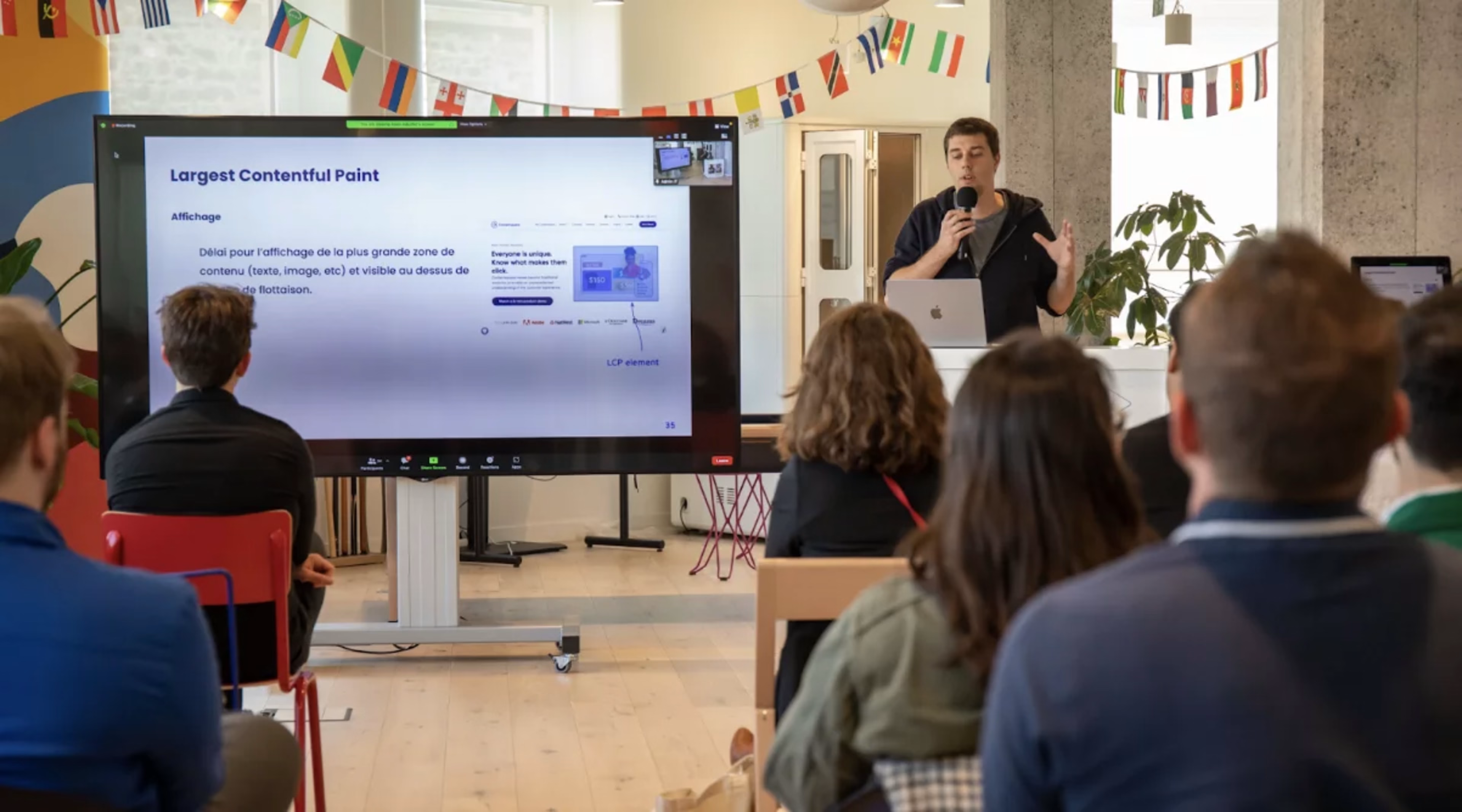The most common question we get from new clients is how to get the most out of our platform as quickly as possible. When so much time and resource is spent on getting an enterprise platform on board, the last thing you want is to find it sitting on the shelf three weeks later, barely touched.

We spoke to Jamie Ritchie, Senior Business Development Manager at Contentsquare, for his top tips on ensuring Contentsquare is immediately embedded into your business. From building the right foundation to encouraging adoption to maintaining usage, here’s Jamie’s best advice for Contentsquare excellence. And, for him, it starts with doing the groundwork…
Set the foundations for success
Any new software (especially at the enterprise level) requires buy-in from your business—you’ll rarely get something over the line on your own. So Jamie’s first two suggestions are based on doing the proper groundwork before you get sign-off for the platform.
1. Take people on the journey with you
For Jamie, adopting a new platform doesn’t begin once the contract is signed. “You have to take people on the journey with you from the start,” he says. So, whether you just learned about Contentsquare or used it at a previous company, with any big investment you need to start the conversations early. Start small, but be intentional. For example, share case studies with members of your team, or suggest they attend a Contentsquare event. As you progress, invite members of your team to demonstrations and workshops and encourage them to ask questions and think of the potential pain points that could be solved using these new capabilities. “By the time you get your hands on the platform, the idea is to have your team chomping at the bit to use it,” says Jamie; this is the first step in ensuring adoption when the platform is live.
2. Build a repository of information, and make this readily available
Many companies have long procurement processes requiring multiple stakeholders’ sign-off to get products and services over the line. “Having a shared repository of information about the platform for people to refer to is important,” says Jamie. “Collating key information (such as why to buy the platform, what problem it’s solving, and what teams will benefit) and having this information readily available will help you build your business case.”
Encourage adoption
With the platform procured, the important part now begins; adoption. Here are Jamie’s best six pieces of advice for ensuring people are bought into (and continually using) your brand-new Contentsquare platform:
1. Find the right champion
Firstly, you need to find internal champions. These are your power users, in charge of sharing insights with the wider business and promoting the platform (essentially to anyone who’ll listen). Whether you assign the role to people manually or your natural champions become apparent early on, it’s critical people are sharing their learnings and familiarizing the wider team with the platform’s capabilities. And these champions won’t just be recognized on your side either. At Contentsquare, we believe in the power of community, which is why every quarter we celebrate our Contentsquare Quarterly Champions (the people who have been most active in the platform that quarter). So make it a goal to get your team on the list!

2. Build KPIs around the platform
Jamie’s second piece of advice is to introduce KPIs based on the platform. “We worked with a shoe retailer recently and the eCommerce director made using Contentsquare part of his team’s KPIs, associating their bonuses with performance optimizations driven by the tool,” explains Jamie. And with most teams used to working in KPI-driven environments, it’s relatively simple to introduce a platform-driven metric to keep everyone focused on the same goals. However, Jamie advises avoiding KPIs based on time spent on the platform. Why? “Well, just because you’re in the platform a lot doesn’t mean you’re using it productively,” explains Jamie. “Instead, KPIs should be based around what insights you’ve learned to improve performance, based off of Contentsquare data.” An example here is setting KPIs around a campaign. From using Contentsquare to analyze your website pre-launch, to agile tweaks and optimizations during the campaign, to a post-campaign analysis; introducing KPIs based on campaign performance and insights will help ensure people focus on driving results using Contentsquare.
3. Make it a habit
“The third step is creating a culture where using the platform becomes a habit,” says Jamie.
We work with a big media company, and each Monday the team has to turn up with a Contentsquare insight from the previous week.
This habit is effective for two big reasons; Firstly, “There’s an element of fear whenever you have to present something, so you go in and learn something to avoid looking stupid,” says Jamie. And secondly, the repetitive nature means you’re consistently going into the platform each week, which helps to create a lasting habit. Another habit could be a new framework for campaign retrospectives. “Contentsquare has 13 months of data retention, so you can retrospectively look back to see how previous campaigns performed,” explains Jamie. For each new campaign, you could set your team the task of reviewing previous campaigns and sharing 1-2 learnings to inform development this time around. Not only will this help improve the platform’s adoption, but you’ll get stronger campaign results thanks to a newfound data-driven approach.
4. Make it fun
Jamie’s fourth piece of advice is to gamify the Contentsquare experience to encourage adoption. Whether it’s offering a monthly gift voucher for your top platform user or creating a leaderboard for the biggest impact driven from a Contentsquare insight, gamifying the experience will encourage healthy competition and adoption of the platform. “I was at a monthly client meeting the other day with members of their UX, content, and product team,” relays Jamie. “They had a leaderboard of the top five users of the platform who were all in the UX team—which made the content and product teams want to get themselves on the leaderboard the following month.”
5. Lead the change
There’s nothing quite like simply being the change you want to see. If you want your team to use the platform, make sure you’re using it and sharing learnings yourself. ”You respect a leader who goes over the line before you do,” says Jamie, providing another example; “A customer experience manager at a global automotive company wanted to see whether color variations in their site’s search bar affected how users interacted with the feature. So he looked into the platform himself to understand the customer journey and then shared his findings with the team.” The more you use the platform and share valuable insights, the more people will want a bit of what you’ve got. This can really help drive adoption, especially if the stakeholder inspires change from the top down.
6. Check-in. Again and again
Just because the platform is up and running—and your business is adopting it—don’t sit back and relax. To get the most out of the platform, you need to be checking in continuously. “Start with your champions,” suggests Jamie. “Have a monthly review where you ask them: ‘How’s is it going? Who else have they spread the love to who’s now using the platform? What challenges and hurdles have you come across?’ This regular cadence of communication and feedback will help ensure your teams get the most from the platform, and that Contentsquare becomes more of a digital partner than just a service.”
Suzanne’s quick-fire implementation checklist
Finally, we spoke with Suzanne Smulovitch, Contentsquare’s Client Success Planner, in charge of ensuring our clients are set up for maximum success when using our platform. Here are her final recommendations for a smooth implementation process. “Congrats! You’ve signed up with Contentsquare, and I bet you can’t wait to use it. One of the best ways to prepare is to have your ducks in a row. So here’s a quick checklist that will enable you to hit the ground running: Prepare your dev team. Ensure that your dev team has reviewed the technical specifications and assigned resources to implement Contentsquare.
Ensure Security and InfoSec have approved the solution for installation.
Think about which variables in your data layer you want to pull through to Contentsquare for segmentation.
Identify who will own and check the PII blocking.
List out the third parties that you want to integrate with Contentsquare.
Prepare your champion team. You should already have chosen who will own Contentsquare, but let them know that things have developed so they can prepare. If you need help identifying the ‘right’ champions, reach out and we can guide you.
Identify which teams will need training and to what level
Align on how you will share insights with the wider team
Discuss getting a ‘value tracker’ in place
Prepare the key use cases for each team that will be using CS
Be transparent. The more transparent you are about your business and its digital maturity, the more we can guide you toward success.
Share your roadmap, governance structure, and current data cycle with your assigned success team. We will align with your business, provide best practices and create a well-grounded success plan together.
If you follow the above advice, you’ll be set for a smooth implementation! And remember, we’re here to help you along the way,” says Suzanne.
Get in touch
Whether you’ve just got Contentsquare and need some help encouraging internal adoption or would like to find out more about how we can help, we’d love to hear from you! For clients, reach out to your customer success manager. And if you’re new to Contentsquare, please say hello to sales!
Katie is Contentsquare’s Global Content Manager. With five years of content experience both agency and client-side, she knows a thing or two about creating content that drives traffic, engages, and converts. She enjoys reading, red wine, and going to bed early. She’s also pretty fond of rooftops and is rarely seen without freshly painted nails.
